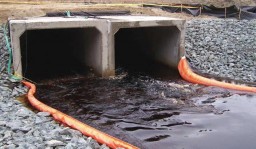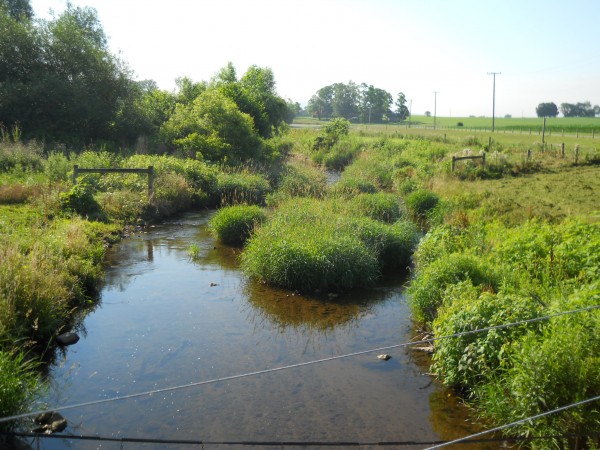Chapter 105 Water Encroachment Permits
Streams, floodways, lakes, ponds, wetlands, and other bodies of water are essential habitats for wildlife, improve water quality of our stormwater runoff, and help to reduce flooding. As a result, activities in or near these features are regulated by state and federal laws. In general, disturbance activities in them typically require a permit.

Permitted activities include, but are not limited to flood attenuation, channeling, piping, bridging, relocation, floodway encroachment, and wetland disturbances.
At this time the DEP recommends all chapter 105 permits be applied for through the e-permit process, if an applicant cannot use this process paper applications are still accepted by the district.
Pond Information
General information on building and maintaining a pond and what permits are needed for these activities can be found here.
Disturbances in and around ponds are reviewed by the Department of Environmental Protection on a case-by-case basis. However, the BCCD can assist you with general technical assistance regarding ponds, regulations associated with them, and potential permits required for building, maintaining, or removing ponds.
Need help determining if permits or other regulatory requirements from DEP are required for bridge and culvert maintenance and repair? DEP’s Bridge and Culvert Maintenance & Repair Tool is an online interactive tool designed to assist bridge and culvert owners in determining what, if any, permit and notification requirements are needed for bridge and culvert maintenance and repair. By answering questions about the bridge and culvert, the nature of the proposed work, and to avoid delays the tool will direct you on how to move forward with your project. Click the button listed below to utilize this tool.
Chapter 105 Water Encroachment Permits
Non e-Permits Procedure
At this time the DEP recommends all chapter 105 permits be applied for through the e-permit process, if an applicant cannot use this process paper applications are still accepted by the district.
Per Pennsylvania's Dam Safety and Encroachments Act (25 PA Administrative Code Chapter 105), a Permit is required for projects involving the construction, modification, or relocation of any dam, water obstruction, or encroachment. The Act defines encroachment as "any structure or activity that in any manner changes, expands, or diminishes, the course, current, or cross-section of any watercourse, floodway, or body of water," which including wetlands.

General Permits (GPs) were created for activities or structures that do not pose a significant threat to flooding or the environment.
The Berks County Conservation District is delegated by the Pennsylvania Department of Environmental Protection (DEP) to review and acknowledge GPs 1 through 9, which meet the conditions of the permit.
Please note that GP-10, 11 and 15 are reviewed by the DEP South Central Regional Office and not by the BCCD.
Streams, floodways, lakes, ponds, wetlands, and other bodies of water are essential habitats for wildlife, improve water quality of our stormwater runoff, and help to reduce flooding. As a result, activities in or near these features are regulated by state and federal laws. In general, disturbance activities in them typically require a permit. Permitted activities include, but are not limited to flood attenuation, channeling, piping, bridging, relocation, floodway encroachment, and wetland disturbances.
Paper GP Submission Requirements – Provide two copies of each of the following to the BCCD:
- General Permit Registration form
- BCCD Project Application & Review Fee Schedule
- Sketch plan or similar site drawing
- Cross Section drawing
- Project Location Map (copy of USGS Topographic map)
- PA Natural Diversity Inventory (PNDI) with Clearances
- Aquatic Resources Impact Table
Please be advised that GP-5 applications proposing Horizontal Directional Drilling (HDD) to bore underneath a stream or wetland require a detailed geotechnical report as part of the application.
Furthermore, the geotechnical report will need to be reviewed by the DEP South Central Regional Office. If your GP-5 application proposes HDD, please be sure to provide the geotechnical report as part of your application to the BCCD.
Permit Types
GP-1 – Fish Habitat Enhancement Structures: This permit is used for the installation of fish habitat structures that have been approved by the PA Fish & Boat Commission
GP-2 – Small Docks & Boat Launching Ramps: This permit authorizes the installation of pile-supported and floating docks on lakes.
GP-3 – Bank Rehabilitation, Bank Stabilization, & Gravel Bar Removal: This permit authorizes projects that involve bank stabilization or gravel bar removal on/in streams.
GP-4 – Intake & Outfall Structures: This permit is used for projects such as the installation of a dry fire hydrant or a “clean water” drainpipe outfall.
GP-5 – Utility Line Stream Crossings: This permit applies to any utility line (gas, oil, sewer, or water) that crosses under or over a stream or wetland.
GP-6 – Agricultural Crossings & Ramps: This permit is to be used when crossings and ramps are installed for agricultural purposes.
GP-7 – Minor Road Crossings: This permit can be utilized when establishing a permanent road (not a parking lot) crossing through a wetland or stream using a bridge or culvert or clean fill material.
GP-8 – Temporary Road Crossings: This permit is used to establish a temporary culvert or bridge crossing.
GP-9 – Agricultural Activities: This permit authorizes agricultural activities (grassed waterways, terraces, diversions, waste storage facilities, spring development, or minor drainage) that encroach into streams or their flood ways.
GP-10 - Abandoned Mine Reclamation (reviewed by PADEP South Central Regional Office): includes the construction, operation, or maintenance of an encroachment or water obstruction for the reclamation of an abandoned mining site.
GP-11 – Maintenance, Testing, Repair, Rehabilitation, or Replacement of Water Obstructions and Encroachments (reviewed by PADEP South Central Regional Office): The maintenance, testing, repair, rehabilitation, or replacement of existing currently serviceable water obstructions or encroachments.
GP-15 - Private Residential Construction in Wetlands (reviewed by PADEP South Central Regional Office): includes the placement and maintenance of fill in, or the excavation of, non-tidal wetlands for the construction or expansion of a single family home for the personal residence.
JPA – Joint Permit Application (reviewed by PADEP South Central Regional Office): includes all those projects that are not eligible for any of the aforementioned GPS.
Additional information
The BCCD is delegated to review Chapter 105 General Permit numbers 1 through 9.
- For more information about Chapter 105 General Permits, you can visit DEP’s website.
- Permit information through DEP
- Guidelines for Maintaining Streams in Your Community
Water Encroachment Documents and Forms
Note: All Project Applications must be sent in to the BCCD with the appropriate documents and the BCCD Plan Review Application & Review Fee Schedule
Permit Forms
LINK - GP Registration Form
PDF | Word - Fee Calculation Worksheet
PDF | Word - Aquatic Resources Impact Table
Regulations and Standard Operating Procedures
LINK - Chapter 105 Regulations
LINK - Chapter 106 Regulations
PDF - PASPGP-6
PDF - Grandfathering of PASPGP-4 Authorizations
E-Permitting
Explore PaDEP's webpage with instructional videos to assist Applicants and Consultants in registering for Chapter 105 e-Permitting.
Useful Links
LINK - PNDI
LINK - Army Corps Philadelphia District
LINK - Army Corps Baltimore District
PDF - USFWS Certified Bog Turtle Surveyors (updated annually)
PDF - Summary Chart of Chapter 105 General Permit Requirements
PDF - Guidelines for Maintaining Streams in Your Community
Presentations
PDF - DEP GP Presentation
